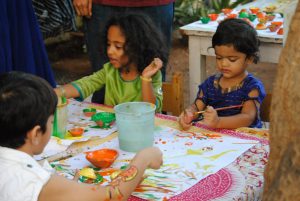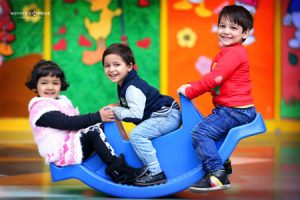
Since the day in 1837 when the first kindergarten class opened its door, the aims have remained the same. It is a space where kids can:
• Tell stories
• Build castles with blocks
• Paint pictures with hands
• Make friends
• Learn to share
But the way these objectives are reached has changed drastically. If you walk into a young kid’s class today, you will  be bombarded with a very different sight. Children will be bent over worksheets and filling them in. Or they will be rote learning flashcards. In different words, kindergarten classes have become a copy of all higher grades.
be bombarded with a very different sight. Children will be bent over worksheets and filling them in. Or they will be rote learning flashcards. In different words, kindergarten classes have become a copy of all higher grades.
This is not what young impressionable kids need. They need a place that is very different from the rest of the school and similar to the original roots of kindergarten. The reason for it is basic. When children play and make castles or weave stories or paint together, they are learning life skills such as:
• Ability to think creatively
• Ability to work with others
These are qualities that every person will need in the coming centuries which is why teaching them in kindergarten is so essential. How do kids gain these valuable capabilities in kindergarten? Any activity that they do is a spiral of learning:
• First, they imagine what they want to do
• Second, they actually create the project using different materials such as blocks or finger paints
• Third, the play with their creations and share it with others which give others ideas.
Explore More About : 4 Reading Materials For Teachers Of Kindergarten
This is precisely what adults do in their jobs and lives. We have to come up with solutions, sometimes extremely creative ones, for unexpected incidences in life. Therefore, the repetitive pattern of playing blocks is the apt preparation a child needs to step into society. The question now is why did the pattern of teaching change so much in kindergarten?
 Even though we know that the roots of our teaching methods were meant to support our societal needs, the process got altered due to our thinking. Right now, we don’t connect much value to creative thinking, and thus, the education system doesn’t emphasise on it. One more reason for the modification is an absence of correct media. For really young students, wooden blocks and finger paints are enough, but as they grow older, they require more materials.
Even though we know that the roots of our teaching methods were meant to support our societal needs, the process got altered due to our thinking. Right now, we don’t connect much value to creative thinking, and thus, the education system doesn’t emphasise on it. One more reason for the modification is an absence of correct media. For really young students, wooden blocks and finger paints are enough, but as they grow older, they require more materials.
Presently, we lack the right media and technology to teach them more advanced concepts. Because we do not have the precise tools and material for such projects, we utilise a different path to learning. But there is hope. Technology has already changed a lot of fields. Education is not far behind. We just need to find the right technology with the appropriate design and utilise it. Through inventions, we can carry forward the kindergarten way of teaching to students of all ages.
Once digital gadgets are put into use in every class, children will grow to be creative thinkers – exactly the kind of adults we will need for the coming generations.





